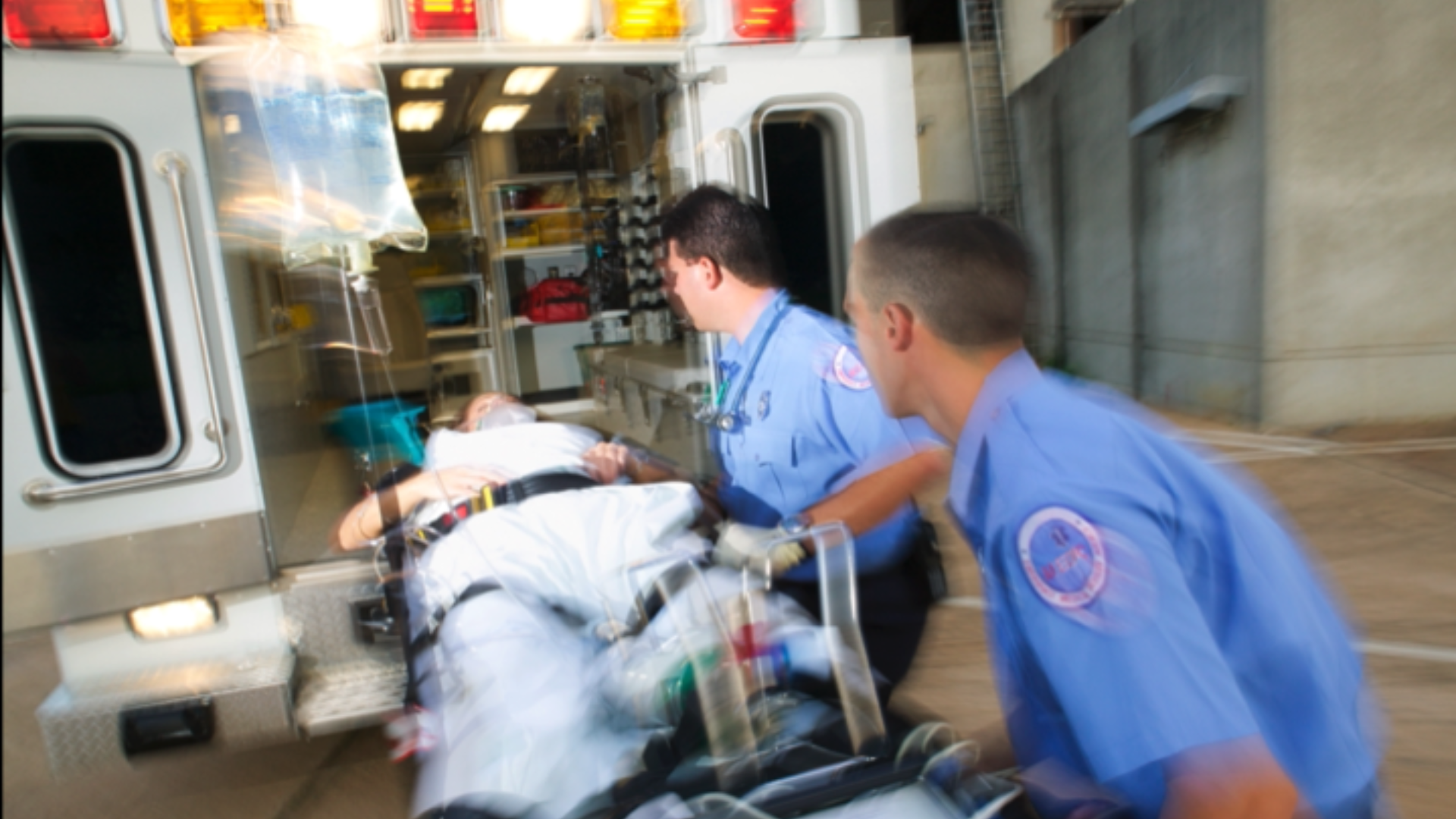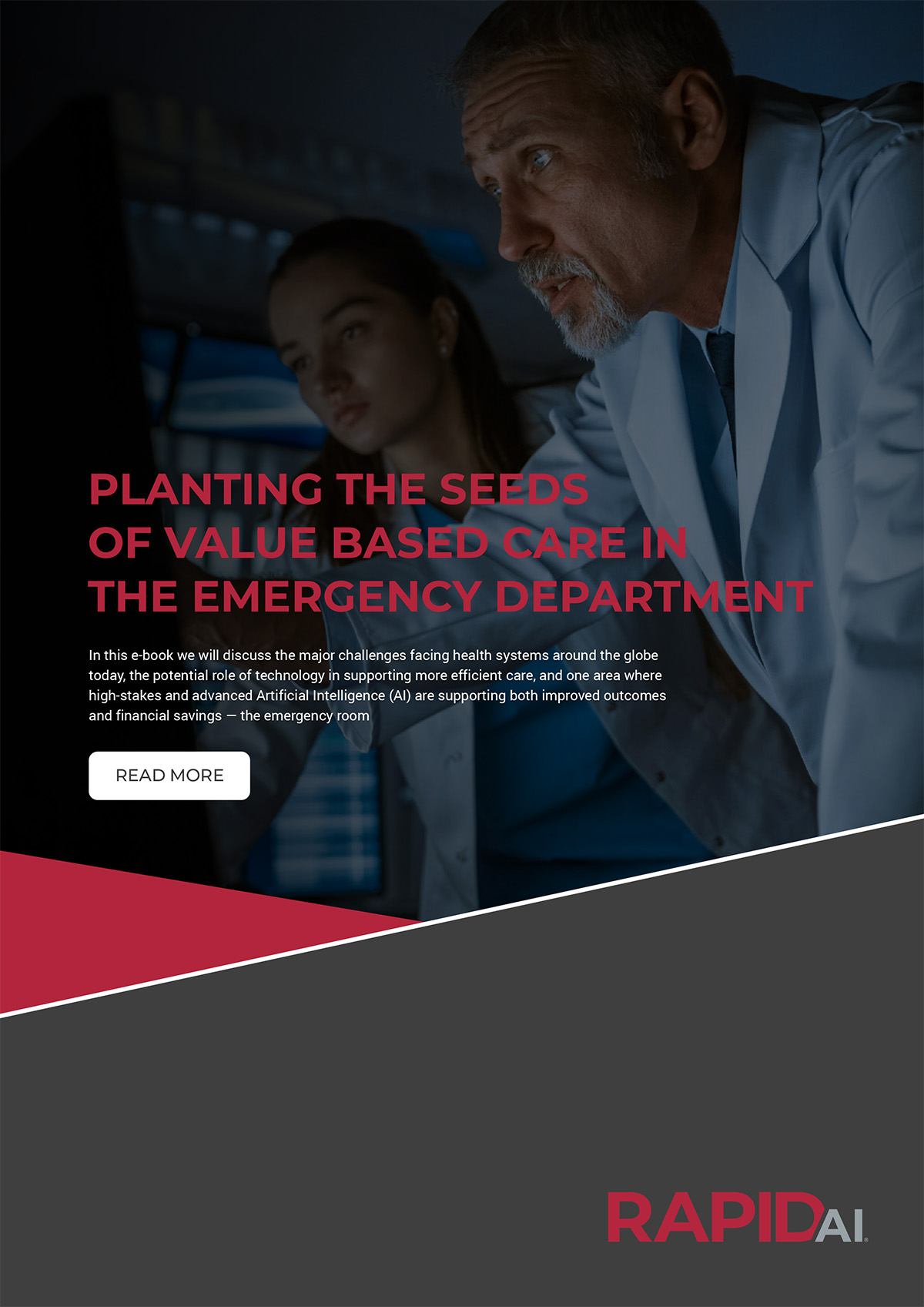This eBook covers the major challenges facing healthcare systems and how the potential role of artificial intelligence can support improved outcomes, financial savings and value-based care in the emergency room
One of the most universal and important shared goals across the global healthcare ecosystem is more quickly diagnosing and treating patients so as to achieve better outcomes faster. Summarized as efficiency, it is at the very core of the U.S.’s ongoing push towards value-based care — a model many agree has enormous potential for transforming healthcare globally but which has yet to be realized at scale.

Healthcare continues to tighten its belt
It’s no secret that across the globe, healthcare systems are feeling the squeeze of enormous financial pressure — with some pointing to 2022 as the most challenging year yet since the COVID- 19 pandemic began.
For example, in the U.S. at least 10 hospitals closed entirely between January and October of 2022, in addition to the dozens of others scaling back services, including emergency departments, maternity and pediatric offerings, and elective or non-emergency surgeries. In fact, a report from the American Hospital Association found that more than half of all U.S. hospital systems are projected to finish 2022 year in negative margins, creating potential ripple effects into 2023 and beyond.
In the U.K., and despite any misconceptions about the solvency of government-sponsored healthcare systems, the National Health Service (NHS) finds itself under similar strain. Record patient demand and an ongoing healthcare staffing crisis has led to significant financial pressures, including as much as an £80m budget deficit in one regional trust.
The situation is much the same in other countries, including Germany, where the German Health Minister is investing 1.3 billion euros into new technologies as the country lags behind in digital transformation, and France, recently considered one of the strongest healthcare systems, is struggling to meet the needs of its hospitals.
While each country faces its own unique challenges, all are experiencing the squeeze of the global workforce shortage, provider burnout, growing patient demand, and lingering (if not worsening) financial ramifications of COVID during a time when demand has never been greater.
Despite the many financial and operational challenges they face, many hospitals recognize the need for continued but strategic investments to help them overcome some of these pressing issues and increase efficiency – one of the more important areas being in advanced technology.

Technology’s value
As technology continues to advance, there is a growing body of technologies that, while requiring initial investment in the short term, can yield invaluable cost savings in the long term. In fact, a recent report from Bain & Company found that software is now a top five strategic priority for nearly 80% of provider organizations. Additionally, more than 95% of providers expect to make new software investments in the next year, and roughly 35% of providers say that because of the current environment, they plan to spend more than usual over the next 12 months as part of their efforts to increase productivity and efficiency.
As hospitals begin to think about strategic new investment, here are some of the areas they should focus on to reap the biggest financial and operational benefits amid shrinking margins and the continuing labor shortage.
- Faster diagnosis
- Investing in technology that supports better imaging, triage, and diagnosis can provide enormous value. From cancer to diabetes, to cardiovascular disease and many others, there is a diverse and growing body of research pointing to the fact that earlier detection and diagnosis can lead to better outcomes— and as a result, cost savings and efficiencies for hospitals and health systems.
- Streamlined communication
- Although every condition and care pathway presents its own unique challenges, nearly all hospitals and departments can benefit from improved communication. Optimizing care team coordination helps physicians provide better patient care by helping them stay updated and responsive to a patient’s changing needs and or other circumstances, work more efficiently with reduced staff, as well as alleviate burnout.
- Data analytics & process improvement
- Given it is so closely connected to and impacts all other aspects of healthcare, many organizations are showing particular interest in technologies which support better and continuous process improvement through data analytics. With advanced technology, the clinical teams can passively collect data, which can be analyzed with AI and automatically generate reports for each member of the clinical team to review when they are able – ultimately allowing the team to look back, learn, and make adjustments to improve care in the future.
A case in motivation – The ER
There is perhaps nowhere where we should be more motivated to take steps towards more efficient care than in the ER
A great example of this – and an area of healthcare where we can make a lot of impact – is in serious, potentially life-threatening, and yet common diseases like stroke, pulmonary embolism (PE), or ruptured brain aneurysm. Combined, these conditions affect 330,000 people each year, but research has also shown that treatment and outcomes can be drastically improved with the help of technology.
A recent study has found that the use of AI to diagnose patients resulted in decreased hospital length of stay. More specifically, AI technology like RapidAI has been shown to reduce door to treatment/groin/CT/decision times by significant margins. It can also contribute to better teamwork, reduce provider burnout, analyze images fast, support better communication, and – perhaps most importantly – improve patient outcomes. There is an immediate ability for healthcare organizations to make an impact and help the greatest number of people by investing in tools that can improve image assessment and workflow for these conditions.
We spoke with Dr. Sanjeev Nayak, a Consultant Interventional Neuroradiologist from the University Hospitals of North Midlands, about the challenges his department is facing, and how technology is helping to improve processes and optimize value-based care in their facility.

What are some of the biggest challenges — whether direct or indirect — that impact your team’s ability to deliver optimal patient care?
One of the top challenges that many NHS hospitals are currently facing is the lack of capital funding. Capital funding is required to support extra clinicians, nurses, radiographers, equipment and transfer/triage pathways. A lack of money is obviously a huge challenge – we do not receive enough money to implement all of the resources needed to properly serve our patients. We need more funding, but in the meantime, we are figuring out how to make it work with the resources we do have.
We are also facing staffing challenges, which many health systems around the world are facing, too. One particular area where we are seeing a severe gap is in the number of anesthetists available – which poses a great problem for all departments. It is not just anesthetists, though – there is a lack of clinicians across all areas. Yet, we are still somehow managing to run a 24/7 service, which is putting a great burden on all clinicians.
More specific to the neurology practice, the greatest challenge we are facing is actually with patient transfers from surrounding spokes to our hospital. Ideally, we like to treat stroke patients within an hour of their arrival to the hospital, and 45 minutes after scanning. Unfortunately, the surrounding hubs do not have the communication resources needed to accurately assess and transfer patients to the right places. These inefficiencies slow this down and often make it difficult to treat patients in the optimal amount of time. Rapid diagnosis and transfer of stroke patients from our spoke hospitals is essential to obtain an optimal patient clinical outcome following thrombectomy.
What are some of the areas in which you have sen the most value from Rapid AI?
The impact of RapidAI’s technology has been clear. Accurate AI imaging brings in a great deal of value for both the hospital and for patients. The technology assists with patient selection, which is very important because when you select the appropriate patients you are able to treat more of the right patients – and treat more patients who you may have previously not selected. Since implementing RapidAI, the number of patients we have been able to see from the local area has gone up.
Also, you no longer have to rely on a radiologist to review the scan and conduct a report – you can now get immediate results with RapidAI. It also helps with the treatment decision and deciding whether you need to perform a thrombectomy. The technology also improves communication between the teams. We can notify the referring team to update them on the patient’s progress, and also notify all of the other members of the team to prepare them for the patients’ next steps. There is also a cost savings element because you can determine the appropriate treatment levels and ensure the patients do not receive any unnecessary procedures. Overall, it reduces a lot of time that would otherwise be wasted – which is ultimately putting the patient at risk.

How can technology help stained stroke networks do more with less?
Overall, technology helps us optimize our workflow to ensure all of our resources are being allocated properly, and that no clinicians’ time is wasted. It speeds up the diagnosis and treatment decision process, notifies all of the necessary team members and ensures they are in the right place at the right time, and ultimately helps get the patient into treatment and back home more quickly. For hospitals struggling with staffing shortages, lack of fundings, and poor communication, technologies like RapidAI can help make processes more efficient and help them “do more with less.”
Now, in some cases, a hospital may not actually have the resources to properly treat a patient. For example, some of our neighboring hospitals do not have the capabilities, certifications, tools, and staff to treat stroke in the way our hospital does. When a hospital system does not have the appropriate resources, AI can also be extremely helpful in determining the best hospital to transfer the patient to so that they receive the right level of care that they need. We have seen a lot of positive impact in one of our spokes in particular due to the implementation of the technology. We are working to support other spokes and surrounding hospitals in this way, too, to ensure all patients in our area are transferred appropriately to receive optimal care.
What are some of the challenges that RAPIDAI has helped you solve?
The main challenge that RapidAI is helping us solve is transfer times. I previously discussed that one of the main challenges our hospital and other hospitals in the area are facing is transfer decisions and transfer times. We are really trying to improve our processes in this area to ensure patients are directed to the appropriate facility to receive care. That is why we implemented RapidAI – to help spokes in the area better assess the needs of the patient and make more informed transfer decisions. So far we have seen great improvements, but we certainly still have a long way to go. As we continue to use and learn from the technology, implement new features and modules, and connect more spokes, we can continue to make improvements, save more time, and ultimately give more patients the care they need.

Can you share any data/information about how RAPIDAI has improved workflow?
Since implementing RapidAI, the number of patients that we have been able to see and treat has increased. Prior to RapidAI, we were able to perform around 100 to 110 thrombectomies a year, but we’re now able to double our numbers and treat more patients – and are hoping to get 200+ thrombectomies a year. The transfer times from our spoke hospitals has also improved since the implementation of RapidAI. We are seeing patients quicker and this translates to a better patient clinical outcomes. RapidAI, with the help of its perfusion imaging has helped us treat more patients with symptoms of unknown time onset and wake up strokes that would not have been treated previously. We are also diagnosing and treating more patients with distal vessel occlusions and thus providing the best possible care to the stroke patients in our region. We are now looking forwards to implementing Rapid for Angio software which will allow us to transfer suitable thrombectomy patients directly to our angiographic suite and thus save further time and help achieve better patient outcomes.
Any specific examples/ cases of patients whose outcomes improved with the use of RAPID?
Some of the most complicated stroke cases are wake-up strokes, which happens when a patient falls asleep with no obvious symptoms of a stroke but wakes up with them. They present a particular challenge for our team because the onset time of the stroke is unclear – making it difficult to determine if the patient is eligible for treatment. These represent about 1 in 5 acute ischemic strokes, so we were seeing quite a few cases each year.
Prior to implementing RapidAI, some physicians did not feel comfortable referring patients for treatment because of the lack of evidence around these cases. Since implementing RapidAI, though, doctors have been able to assess the damage done to the brain and whether or not the patient is a good candidate for treatment. Our team can now treat any stroke without questions or hesitation – meaning more patients’ lives are saved.
Find out more on implimenting RAPIDAI
To read and download the full eBook ‘Planting the seeds of value-based care in the emergency department’ click here


